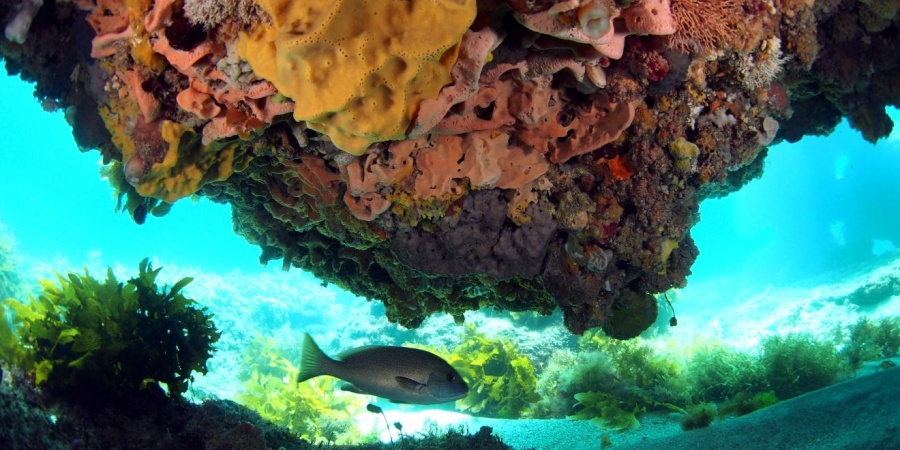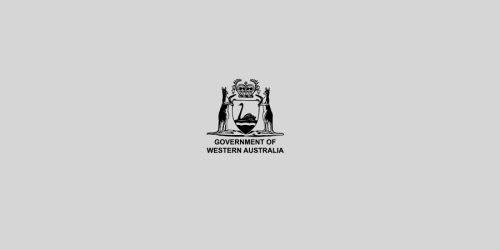
Burns Reef - Marmion Marine Park. Photo Pam Sutton DBCA
Whadjuk Noongar traditional owners will be offered joint management of the marine park under the Conservation and Land Management Act 1984 (CALM Act) through a section 56A Joint Management Agreement (JMA) between Whadjuk people and the DBCA. If joint management is to occur, the JMA establishes a Joint Management Body (JMB) with traditional owner and DBCA representatives to oversee management of the proposed extended park in accordance with the management plan.
What is a Marine Park?
Marine parks are created to help conserve marine habitats and biodiversity, as well as cultural heritage values, while at the same time allowing a range of activities, such as fishing, diving, boating and tourism.
Marine parks provide a place to showcase our distinct marine life relatively free from human impacts. Marine parks also provide opportunities for scientists to help improve our understanding of the marine environment and for marine park managers to educate users about the unique values of the marine park.
The State Government is progressively creating a representative system of marine parks and reserves in WA. The long-term goal is to provide protection for all types of marine habitats and biodiversity using a system that is ‘comprehensive, adequate and representative’. Marine parks in WA are created under the Conservation and Land Management Act 1984 and are currently vested in the Conservation and Parks Commission.
Why is Marmion Marine Park Management Plan being reviewed?
The existing Marmion Marine Park Management Plan 1992-2002 is outdated. A revised management plan will consider the extensive knowledge gained over the past 30 years to provide an adaptive, outcome-based management approach, complete with new targets and performance measures. The opportunity to review and extend Marmion Marine Park was triggered by an excision for the Ocean Reef Marina redevelopment.
Why is an expansion to Marmion Marine Park proposed?
An expansion to the Marmion Marine Park is being proposed to enhance protection of intertidal and subtidal macroalgae reef communities, sea grass beds, important habitat for the endemic Australia sea lion (Neophoca cinerea) and an array of seabirds. An extension to the park will also allow management frameworks to be put in place to manage the expected increase in use of this area into the future.
What is the proposed boundary for the expansion marine park?
Download the map - proposed boundary for extended Marmion Marine Park.
What activities will be allowed in the marine park?
Marine parks in WA are multiple-use areas, meaning they have different zones allowing different types of activities. While a range of activities are permitted in multiple-use marine reserves, not all activities are appropriate in all areas. Marine park zoning plans define what activities can occur within each zone to conserve marine habitats and biodiversity and separate potentially conflicting activities. Zoning is an important management tool used to conserve the values of the marine park that people enjoy.
Marmion Marine Park will continue to be managed for multiple-use, with zoning to be determined through the planning process based on community input.
What are the different types of zones within a marine park?
The different types of zones within a WA marine park are:
- General use zone - zoned to conserve the natural environment while allowing sustainable commercial and recreational activities to continue.
- Recreation zone - zoned for recreational purposes, including recreational fishing where it is compatible with the specific recreational purpose of the zone. Commercial fishing is prohibited.
- Special purpose zone - zoned for a specific conservation purpose, such as protection of marine habitats or cultural heritage values. Commercial and recreational activities which are compatible with the specific conservation purpose of the zone are allowed.
- Sanctuary zone - zoned for conservation purposes, so all plants and animals are protected. Sanctuary zones are ‘look but don’t take’ and the only zone where all types of fishing and collecting is prohibited. People can still enjoy nature-based recreation, such as diving, snorkelling, boating and nature appreciation within sanctuary zones.
Will recreational fishing be allowed in the extended marine park?
Yes, you will be able to continue to enjoy fishing in the proposed extended Marmion Marine Park. The marine park will be multiple use, and the zoning scheme will be carefully designed to minimise impacts to recreational fishers while still conserving representative habitats and biodiversity. Recreational fishing rules will continue to apply within the marine park. For more information, see DPIRDs Recreational Fishing Guide.
Establishing some zones where extractive activities are prohibited allows scientists to carry out long term monitoring of plants and animals relatively free from human impacts. These zones provide important reference sites, for comparison with areas where extractive activities are allowed or where environmental impacts may be occurring.
The proposed extended marine park will be carefully designed to minimise impacts to recreational fishers, while helping to ensure a healthy marine environment that will support sustainable fishing into the future.
Will commercial fishing be permitted in the extended marine park?
Commercial fishing is important to the WA economy and community. The commercial fishing industry supplies fresh, sustainable, and locally caught fish to local and WA families, as well as restaurants, cafes, fresh fish retailers and fish and chip shops. The commercial fishing industry is an important employer and supports a wide range of secondary and related businesses such as fuel, ice, bait, and gear suppliers, as well as maritime servicing and maintenance.
The marine park will be multiple use, and the zoning scheme will be carefully designed to minimise impacts to commercial fishers while still conserving representative habitats and biodiversity.
Commercial fishers are encouraged to attend consultation meetings and provide input during the planning process, including making a submission when the indicative management plan is released for public comment.
How will commercial fishers affected by the proposed review and expansion of Marmion Marine Park be compensated??
The Fishing and Related Industries Compensation (Marine Reserves) Act 1997 (the Act) is the legislated mechanism for compensating a commercial fisher where a marine park results in a reduction in the market value of their authorisation. The compensation process is coordinated by DPIRD. The Act is triggered by certain ‘relevant events’. DPIRD will advise fishers when applications for compensation can be made.
DPIRD recognises that the Act has proven challenging to implement, so will work with the Western Australian Fishing Industry Council to identify a more strategic, potential alternative means of compensating fishers than provided by the Act, noting that while the Act remains in force, fishers have the right to apply under this legislation.
How will tourism interests be accommodated in the marine park?
The proposed extended marine park will be managed with the aim of encouraging visitors and locals alike to respect the area’s biodiversity while enjoying recreational activities such as wildlife watching, fishing, snorkeling and diving. The management plan will allow for appropriately licensed commercial tourism that is compatible with the purpose of the marine parks. The proposed marine park may also provide opportunities for cultural tourism in partnership with the traditional owners.
What is the difference between the Two Rocks Marine Park off the coast of Perth's northern beaches and the proposed extended Marmion Marine Park?
The Two Rocks Marine Park (Commonwealth) off the coast of the Perth northern metropolitan beaches is managed by the Australian Government. It is in Commonwealth waters which extend from the limit of State waters in the east, to the limit of Australia’s Exclusive Economic Zone in the west, and from Burns Beach in the south to Two Rocks in the north.
The proposed extension to Marmion Marine Park will be located within in State waters - the area of ocean extending from the shoreline to the limit of State waters.
As the Two Rocks Marine Park is further offshore, it conserves different marine ecosystems, habitats and biodiversity to the proposed extended Marmion Marine Park. It is intended, where appropriate, to make management arrangements between the State and Commonwealth parks complementary.
More information about Australian Marine Parks can be found at http://parksaustralia.gov.au/marine.
How will Traditional Owners be involved in managing the proposed marine parks?
Whadjuk Noongar Traditional Owners will be offered joint management of the marine park under the Conservation and Land Management Act 1984 (CALM Act) through a section 56A Joint Management Agreement (JMA) between Whadjuk people and the DBCA. If joint management is to occur, the JMA establishes a Joint Management Body (JMB) with Traditional Owner and DBCA representatives to oversee management of the proposed extended park in accordance with the management plan.

